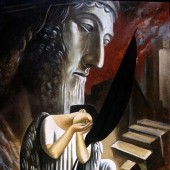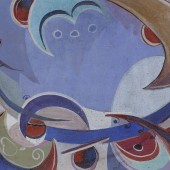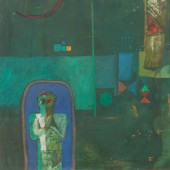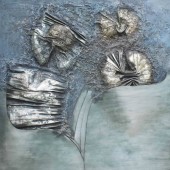
Frequently drawing his subjects from quintessential scenes and characters of Iraqi life, Faisal Laibi Sahi is a socially engaged artist whose work sometimes has a satirical and theatrical quality, and often acts as allegories for social, political, and historical events. In this painting, Sahi depicts a mournful funerary scene. The monumental work conveys the linear spatial configuration of a funeral procession whereas the repetition of the figures suggests the importance of community in the bereavement of a martyrs’ life. The composition is permeated with a sense of melancholy—most evident in the saddened eyes of all the figures and the grief-stricken gestures of the women. According to the artist, the female at the bottom right, who alone looks turns to the viewer, represents the Arab woman, the generations of mothers who lost their sons and daughters to brutal regimes and to a series of wars. Singled out amidst a preoccupied cast of characters, she questions the spectator to ask why this scene is so common an occurrence.
Sahi graduated from Baghdad’s Institute of Fine Arts in 1968 and from the Academy of Fine Arts at Baghdad University in 1971. He continued his training in Paris at École Nationale Supérieure and the Université de la Sorbonne from 1980 to 1981. Sahi also published a London-based satirical newspaper, Al Meirasha from 1992 to 2002. For the past three decades, he has lived in London yet acquires continual inspiration from the rich cultural heritage of pre-Islamic Mesopotamian civilizations, namely Sumeria, Babylon and Assyria.
يبدع الفنان التشكيلي العراقي فيصل لعيبي صاحي لوحاته عموماً من وحي مشاهد وشخوص الحياة العراقية، إذ ينخرط في صلب الحياة الاجتماعية للخروج بأعمال ذات طابع مسرحي ساخر، غالباً ما تكون استعارات ترمز إلى أحداث اجتماعية وسياسية وتاريخية. ويصوّر صاحي في لوحة “الشهداء”، مشهداً جنائزياً حزيناً. ويمثل هذا العمل الضخم البنية المكانية الخطية لموكب الجنازة، ويوحي تكرار الأشخاص بأهمية المجتمع في العزاء بفقدان الشهداء. ويتخلل هذا المشهد إحساس غامر بالكآبة – وهذا يبدو واضحاً في تصوير العيون الحزينة لجميع الأشخاص وملامح النساء المفجوعات. ويقول الفنان صاحي أن المرأة المرسومة أسفل اللوحة إلى اليمين، وهي الوحيدة التي تلتفت إلى المُشاهِد، تمثّل المرأة العربية وأجيال الأمهات اللواتي قد فقدن أبنائهن وبناتهن للنظام الفاسد ولسلسلة من الحروب. وقد تفردت وسط الشخصيات المهمومة لتبدو وكأنها تسأل المشاهد عن سبب الحدوث المتكرر لهذا المشهد.
تخرّج صاحي من معهد الفنون الجميلة في بغداد عام 1968، ومن أكاديمية الفنون الجميلة بجامعة بغداد عام 1971. وأكمل دراسته في مدرسة خريجي الفنون الجميلة في باريس وجامعة السوربون بين عامي 1980 و1981. وأصدر جريدة “المجرشة” الساخرة في لندن بين عامي 1992 و2002. وما يزال صاحي يعيش في لندن منذ ثلاثة عقود حتى الآن، إلا أنه يستمد إلهامه بصورة مستمرة من التراث الثقافي الغني لحضارات بلاد الرافدين التي ازدهرت قبل الإسلام وتحديداً الحضارات السومرية والبابلية والآشورية.







